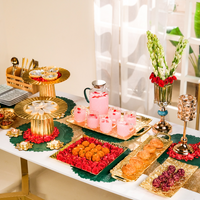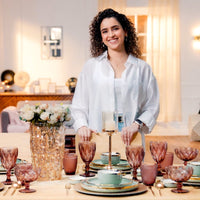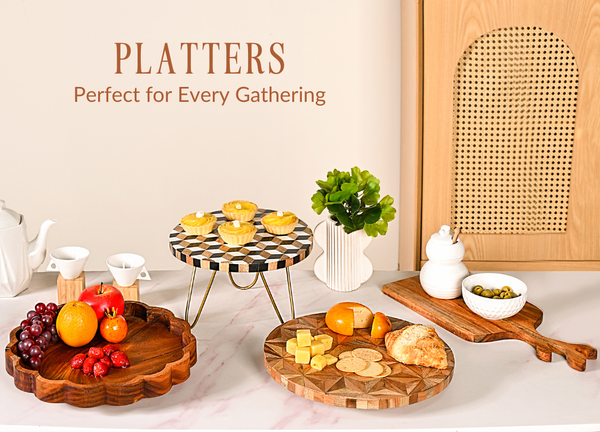Nowadays, a lot of people want to add some touch of ethnic art to their interiors- whether through home decor, crockeries, or furnishings. To maintain a similar essence of color and design which has been prevalent in India for ages, traditional methods like embroidery, block printing, and weaving are combined with modern digital technologies.
Inspired by the ornate designs and color inspirations, we present you a list of decor ideas that have been classified according to three different parameters based on the Indian artistic influences:
PATTERN:
1. Floral Saga: Indian themes draw influence from the vast range of flora and lush greenery which dominates the Indian subcontinent. Indian iconography and culture both prominently include flowers like marigolds, lotuses, and jasmine. Mostly they are not the direct representations but more abstract and contemporary versions. These can be observed in artwork and architecture as well as at religious ceremonies, marriages, and celebrations. Particularly revered as a flower of beauty, grandeur, and elegance, the lotus is also designated as India's National Flower.
Instead of being genuine, Indian floral patterns are frequently stylized, serving double duty as highly ornamental artwork. Popular design themes include elaborate flower trellises, which may heighten a space particularly well to create an air of occasion in dining rooms and halls.
2. The Royal Touch: India has always been the epitome of royalty and extravagance. From Mughals to the Colonial era- imperial white and tones of gold have certainly made a prominent mark in architecture and designs. The evergreen and timeless charm of the classic white and gold decor is something that suits every modern home. From keeping it minimalistic to going all overboard, it’s soothing yet a treat to the eyes.
Our Aurelia collection is a perfect embodiment of the regal combination of white and gold. It is a blend of elegance and grandeur. Plates and bowls with the beautiful gold pattern around the rim make opulent additions to one's dinnerware collection. These elegant plates are a must-have because they are not only tasteful but stylishly made. The collection is ideal for a regal setting thanks to its timeless glazed surface and eye-catching gold embellishments.
3. Geometry in Indian homes: A large part of Indian design is frequented with the use of chevrons, diamonds, and arabesques, among other geometric shapes. Simple squares or circles can also be interlaced and overlapped to create repeating hypnotic patterns that can be used on a local or large scale. 
These designs are prevalent in Indian architecture, including tilework, carving, ceramics, carpets, and leathercraft. These symmetrical patterns provide contrast to flowers and other abstract patterns and are frequently used in conjunction with them to maintain a balanced aesthetic.
One can jazz up any interior from the basic to powerful patterns when geometric designs are added. There are many modern and contemporary prints to choose from. They have vivid colors that flare out to mimic Desi Indian Art and abstract, nonrepresentational designs like lines, triangles, and hexagons.
4. Petrichor: Usher the ethereal essence of Indian soil into your home. Soak in the soothing smell that emanates from the earthy soil when the first long-awaited spells of rain hit the thirsty ground after the scorching summers. Clay pottery is a great way to relish the delight that petrichor has been inducing during the monsoons.
The crockery from the Soboku collection is a reminiscence of those memorable days. Uplift the cottage-core aesthetics of the Indian homes by serving an array of cuisines in the ceramic earthenware bowls. Adorned with two circular rings of vibrant shades against the subtle beige base, the clay bowls and plates look one-of-a-kind. From formal dinners to a casual house party with friends, the versatile serving bowl can be used to represent the sweet aura of Indian earthiness.
5. Tale of Tassel: The concept of tassels can be traced back to the South Indian sculptures from the 16th and 17th centuries which depict seated bulls with bells, clappers, ribbons, and tassels carved on them. There are statues of young women wearing decorative belts, sashes, and striking stances.
The most well-known statue, which dates to 1511 and depicts Shiva dancing with one foot lifted and draped in flowing scarves and tassels, is known as the "Nataraj" or "Dancing Shiva" statue. During the Middle Ages, cloaks or mantles were fastened with metal decorations called "tasseaus," which derives from the Latin word "tassa," which means clasp.
Tassel making is likely as old as weaving, and as people learned about patterns and motifs, the concepts of trims and tassels evolved. Tassels were developed from braids that had been first twisted, knotted, and designed to fit apparel and home furnishings.
6. Conversational Prints: From Indian textiles to Indian architecture, storytelling through motifs has always been prevalent throughout. Indian design frequently incorporates scenic elements as a storytelling tool. Like in many other cultures, traditional storytelling techniques like word-of-mouth are frequently employed to recount the past, impart knowledge, or instill certain morals in young listeners.
These stories frequently take place in very real settings, but they may also feature mystical beings and mythological creatures that heighten the suspense. The same is true of interior designs; much like folkloric elements themselves, they help to conjure up a fantasy world into which one might withdraw. The sheer variety of colors and styles available makes it simple to find something that will sit wonderfully in your home, and scenic motifs will appeal to both youngsters and adults. One such eclectic print is seen in our Ikebana collection which narrates stories of the oriole bird singing in the solitude of nature.
TECHNIQUE
1. Hand painting: In Indian art, hand painting has a very long heritage and history. The earliest paintings in India date back to prehistoric periods and are found as petroglyphs in sites like Bhimbetka rock shelters. About 10,000 years ago, some of the Stone Age rock paintings were discovered among the Bhimbetka rock shelters. It evolved over the years and now can be found in stylized form in various Indian handicrafts.
2. Wood Carving: One of the oldest traditional crafts of India is the art of wooden carving. One form of wooden carving originated in a small village in Karnataka, known as Channapatna which is a craft of toy-making. These eye-catching items are crafted from delicate ivory wood and given a glossy lacquer finish. The most interesting fact is, the lacquer is manufactured from specific vegetable dyes and is entirely organic. Get yours from our collection and make a statement in your home with these traditionally handcrafted things because they are environmentally friendly, non-toxic, and incredibly safe to use.
3. Natural Grass Weaving: The meticulous craft of grass weaving in India can be observed in several parts of the country. Originally a women-dominated craft, two of the natural grass weaving crafts of Sabai and Moonj hail from Odisha and Uttar Pradesh respectively. Their distinctive technique and skilful craftsmanship make Sabai and Moonj crafts eye-catching and appealing.
4. Hand Embroidery: The history of hand embroidery can be traced back to the 16th century, which gained popularity in India under the reign of Emperor Akbar due to his keen interest in the aesthetics of textiles. The art of embroidering involves the usage of a needle to sew strands of yarn or thread together to create patterns, motifs, or abstract designs to decorate fabric. The sewing of embellishments like beads, metal strips, pearls, mirrors, and sequins elevates the look and feel of the embroidered surface.
The Longpi artefacts get their glazed appearance and texture by being rubbed against a local stone, an ancient art form that is still practiced today largely by elderly women. A unique speciality of the Longpi pottery is that it keeps the meal warm for longer periods of time. These serveware provide a spectacular minimalist touch to your cookware which lends an air of elegance that is sure to wow any visitors you have over.
6. Knitting: Knitting is indeed a favorite pastime of women in the Indian subcontinent during the cold winters which came to India only during the British era from Europe. Christian missionaries helped in spreading this skill as girls were taught knitting in schools. But due to industrialization, machine knitting took a toll on the hand knitting process around the mid-19th century. Nevertheless, both techniques have their own charm when crafted into elegant apparel and furnishings.
STYLING
1. Mixing patterns: Indian style decor has always been about extravagant motifs and articulated patterns. The trick is to artfully balance the right patterns backed by the burst of vibrant shades.
The prints and patterns trend has also made its way into decorating our homes, much like the numerous fashion fads that frequently bleed into our interiors. This unforced blending of patterns and colors can be seen as a resurgence of the extremely distinctive style that was popular from the late 1980s to the early 1990s.
Play with the idea of visual arrest by contrasting subtle and overt design elements. For instance, choose some color accents and coordinate the colors in smaller items like table runners, blankets, or a vase if your wallpaper, sofa, or bedcover prominently displays a striking floral print.
For kitchen and dining, one can mix and match coasters and mugs with prominent Indian floral and geometric patterns. Even though it’s necessary to pay attention to the hues, remember that the patterns might be anything.
2. Playing with bold colors: Be bold and bright. Bright greens, reds, yellows, and blues are the epitome of Indian traditional home decor. Indian home décor is renowned for welcoming anything that stands out before fusing it all together.
The defining characteristics of the Indian style is highlighted with a lot of hues and textures in a bright room or a few bright accents in a dark room. Indian homes have always been very warm and welcoming. It's important to create a cozy, welcoming environment for visitors and residents. Besides the earthy tones of muted red, brown and orange, there are rich and welcoming hues like flamboyant fuchsia, prussian blue, and violet. To break the monotony, you may add a couch in a light color. Then there are the colder tones, which are hardly found in great quantities and include beige, grey, and pale blue.
Remember that Indian designs frequently select tones that are separated from one another on the colour spectrum for maximum impact when combining colours. Popular colour combinations like purple and yellow, blue and red, and pink and green are frequently used to create contrast between accents or make sure that patterns do not blend into one another.
3. Embracing the Baithak style: The Indian style of sitting on the floors has a charm of its own. It showcases the essence of togetherness which can never go out of fashion. Sitting on the ground with folded legs surely represents next level comfort. For a cozy and welcoming seating arrangement, move over the couches and chairs, lay the floor with multi coloured rugs and cushions to elevate the look.
The typical modern seating arrangement is often abandoned in favor of something a little more comfortable, such as sitting cross-legged on the rugs and carpets, relishing a warm cup of tea over gupshup. The evening sesh of “chai pe charcha”, gupshup over snack biscuits or garma garam pakoda- all are the essence of Indian houses that brew over the steam of every warm cup of elaichi chai. The look of your living room or entertainment space will be elevated with the traditional Bhartiya Baithak, which literally translates to a low-height seating arrangement. This may be a spectacular place to chill with friends and family, all thanks to the cozy furnishings and warm lighting.
4. Go all wooden: From modular kitchens to smart appliances, the wide range of design and color possibilities that are available now did not exist in the traditional houses. The numerous tall, heavy wood cupboards that lined the kitchen? These cabinets offered kitchens a warm, cozy feeling and were the ideal match to the typical brick-walled kitchen counters, whether they were painted or left wood to show off their grain.
Wooden textures never go out of style. They have the ability to simultaneously appear traditional, refined, and stylish. Therefore, wood is your go-to feature if you want your basic living room to have the ideal blend of ethnic and contemporary style.
You might choose a trendy wooden panel for your false ceiling or utilize textured wooden wall claddings. Of course, you can choose wooden shelves or cabinets, as well as wooden trays and cheese boards for the dining table. Just make sure the living space receives adequate light; otherwise, the wood will make it appear dark. You can also go for light-colored wood as an alternative.
5. Plants in the courtyard: Everyone is enchanted with the magic of greens and thus it has emerged as a vital aspect of every Indian home. The best piece of décor which not only adorns the interiors but also purifies the air, is indoor plants. They brighten every space and make you feel better. Having plants in your living room would only help you to attract greater prosperity, as they are a symbol of it. Gone are those days when only courtyards and front lawns were enveloped with lush greenery.
With the shortage of spaces, plants have been brought into our living spaces. From modern to rustic, lush, green plants in vivid, textured clay pots will complement all decor. You might start by choosing some low-maintenance indoor plants. They can be placed in a row against a plain wall that has a single artwork on it or all together in a vacant corner. If your living space is relatively small, hang planters near the window sill or put a few tiny ceramic vases here and there. In case you are having a tough time maintaining your garden, the ornamental plants and vines from Nestasia are here at your rescue.
So, how would you spruce up your desi home?
























































